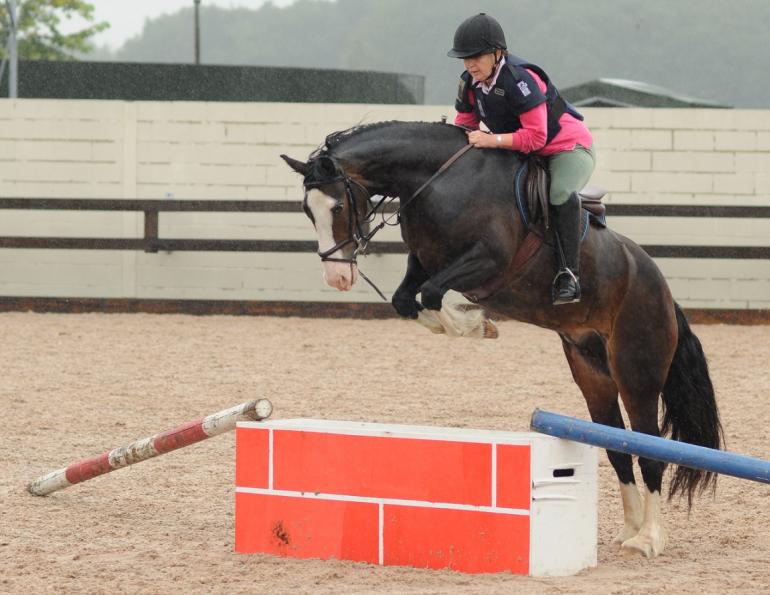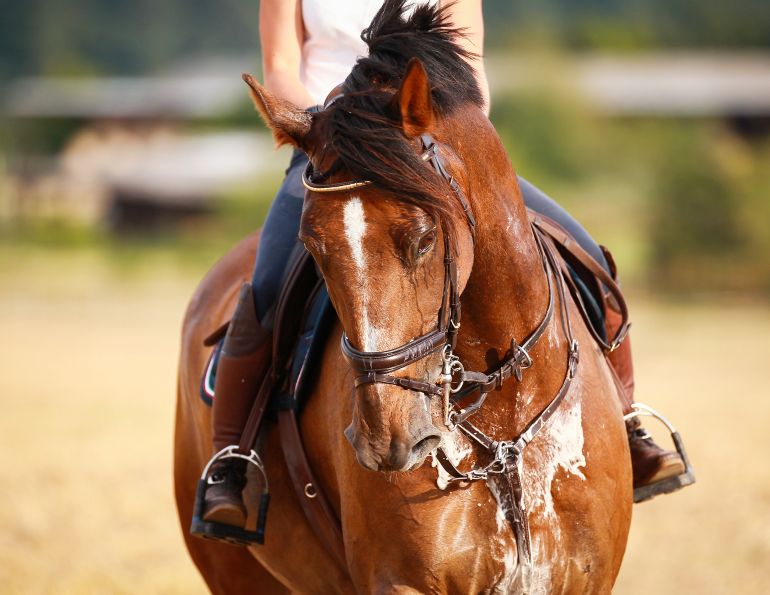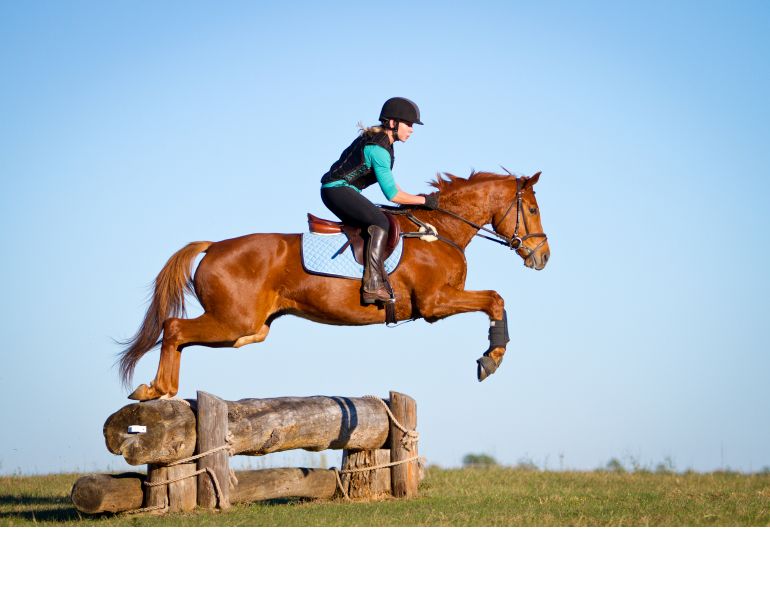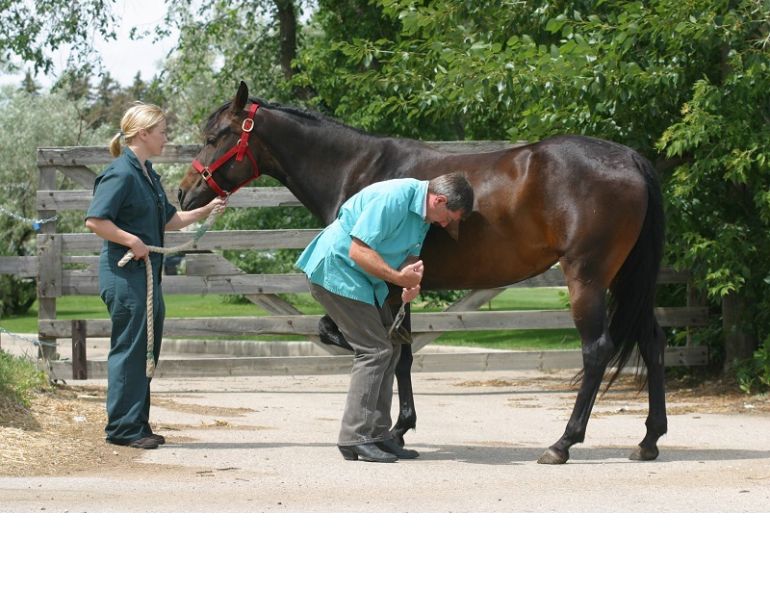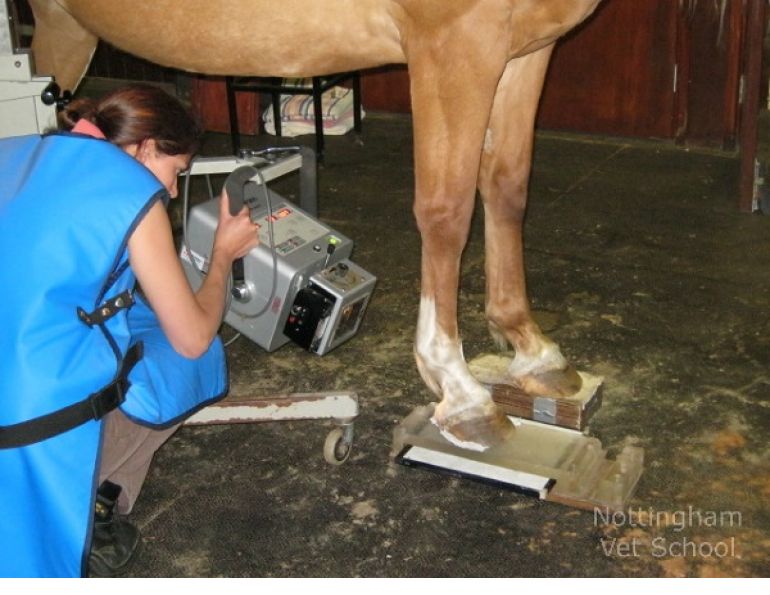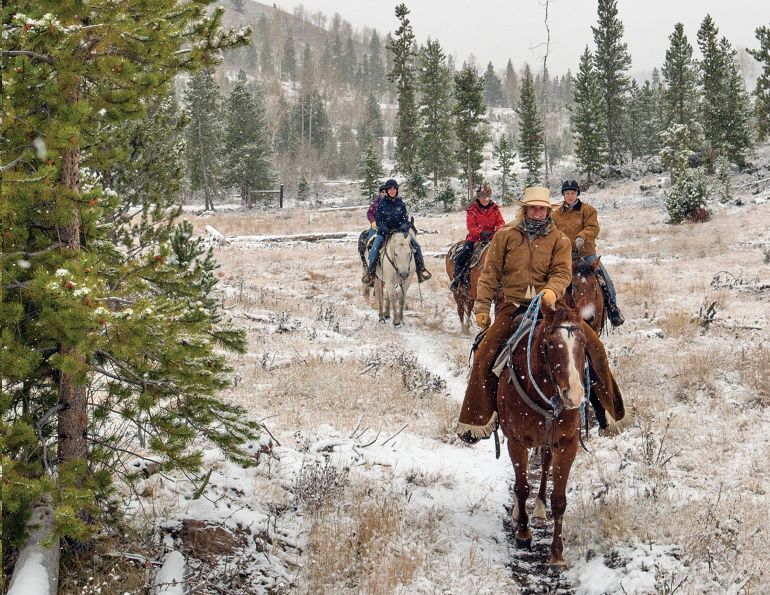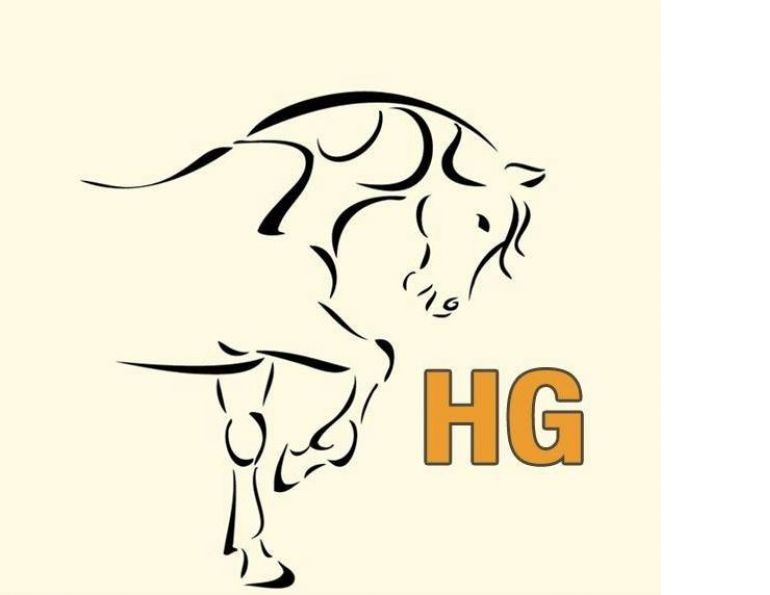Head Tossing. Bit Resistance. Sensitive Ears. Baffling Behaviour. Does Your Horse Have TMD?
By Margaret Evans
Does your horse have trouble responding to the bit? Does he hold his head awkwardly at times, or seem to have problems chewing? Does he show unexplained behaviour under saddle or have problems with certain gaits or leads? Or does he toss his head a lot, especially when pressure is applied with his bit or perhaps a hackamore?
These symptoms may be indicators of a wide variety of conditions that should be checked by your vet. But your horse may also be showing signs of TMD, a disease of the temporomandibular joint (TMJ) located just below and in front of the ears, one each on either side of the head.
Other symptoms that may indicate a problem include uneven wear of the teeth which would be noticed by your vet, cribbing, ear sensitivity, difficulty flexing at the poll, head shyness, and sensitivity around the jaw.
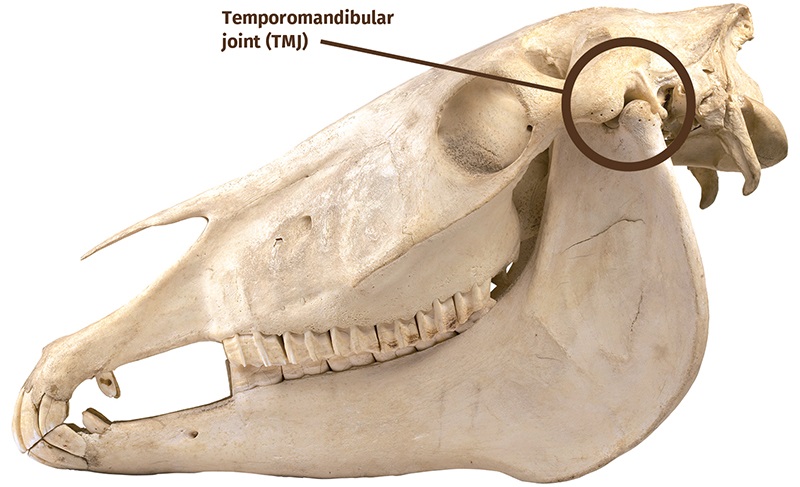
Photo: Shutterstock/Wallenrock
In April 2016, Kim Rose, a professional equitation and hunter/jumper trainer in Delta, British Columbia, purchased Julio, a three-year-old Trakehner/Thoroughbred gelding. He was a beautiful mover and athlete and generally well-behaved under saddle, but he began to have episodes of going from cool to explosive on the lunge line, and his bucking and galloping were beyond simple fresh play. He was completely unpredictable with ballistic, almost angry, reactions.
“Julio periodically appeared uncomfortable and didn’t finish his hay overnight,” says Rose. “He liked to stick his tongue out the front of his mouth when in his paddock, stall, or in the cross ties, but has never done so when bridled or working on the ground or under saddle. He has always been schooled in a rubber Happy Mouth Mullen loose ring bit with a plain noseband adjusted loosely and no [other] equipment. I simply do not believe in or use any sort of restrictive or forceful equipment other than loose, evenly-adjusted side reins on occasion and when lunging.”
But in May 2018, she observed an intermittent audible clunking from Julio’s head. Research led her to suspect a TMJ problem, but a subsequent visit by her regular vet yielded nothing.
By the fall, the sound was more frequent. Rose was worried. She stopped riding Julio and sought further veterinary advice. Radiographs taken by veterinarian Dr. Robyn Kopala of Meadow Lane Equine Clinic, Surrey, BC, revealed that Julio had a radiopaque fragment in the middle of his right TMJ. Further examination and consultation led to Julio having an arthroscopy of the right TMJ. But the procedure did not reveal the location of the chip, although synovitis and articular cartilage damage was evident. Flushing the joint removed several small pieces of cartilage.
The problem did not go away. By early December 2018, the clunking sound was back, and it was clearly bothering him. Rose was at a crossroads. In Julio’s condition, she knew he was not safe for saddle work and could not be sold. But she wanted answers. Online research led her to Dr. Travis Smyth’s thesis Osteoarthritis of the Equine TMJ. Smyth was a graduate student at the Western College of Veterinary Medicine (WCVM), University of Saskatchewan, and Dr. James Carmalt was his supervisor throughout his surgical residency and post graduate degree. In no time, Rose was in touch with Smyth who introduced her to Carmalt. On January 19, 2019, Rose loaded Julio into the trailer for the journey to WCVM, Saskatoon, for a CT scan, tests, and full examination. She had no idea at the time that Julio would not be coming home until June.
Research into TMJs recently took a major step forward. The Mark and Pat DuMont Equine Orthopedics Research Fund awarded $50,000 to Carmalt for a study focusing on the TMJ joints. In addition, he received a graduate student stipend of $18,000 to support his research team’s work on the investigation of the impact of TMJ inflammation on equine performance.
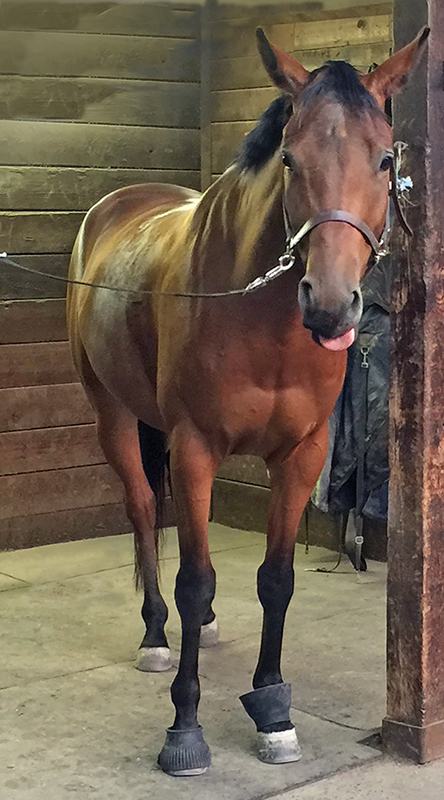
Prior to surgery, Julio with his tongue out for pain relief. Photo: Kim Rose
People typically say their horse has “TMJ” when referring to this condition, but that is something of a misnomer.
“All mammals have two TMJs (one on each side of the head), allowing the mandible to be hung under the cranium,” says Carmalt. “I’m trying to talk people out of calling this problem ‘TMJ.’ TMJ, when used in this manner, is actually a colloquial term for disease of the temporomandibular joint (which can be shortened to TMD). Failure to respond to the bit, ‘rein- or bridle-lameness’ which is only visible or felt by the rider, or unexplained explosive behaviour under saddle may be associated with TMD. It is important to rule out other causes such as pain from the neck or back, other causes of lameness, or behavioural problems before focusing on the TMJs. At this point, the TMJ should be treated like any other joint. Local anesthesia (a joint block) should be performed, and the horse re-assessed. If this fundamentally changes the movement of the horse, or ameliorates the offensive behavior, then it is more likely that the TMJ(s) are the source of the problem.”
Related: Happy Hyoids! The Equine Hyoid Bone
The causes of the disease may be many and varied and several suggestions have been put forward. Causes might include horses eating out of raised hay racks, use of restrictive nosebands, improperly fitted saddles, a rider’s hard hands, faulty hoof care leading to improper gaits, or even lack of pasture grazing such as when a horse cannot naturally lower its head and eat off the ground. And horses can injure themselves with panic reactions.
“In a panic-pull attempt to escape a ‘head caught between gate and post’ situation, my Thoroughbred-cross youngster sprained his TMJ,” says Judy Todd, a physiotherapist in Abbotsford, BC. “He had difficulty opening his mouth wide enough for an apple and there were some impressive clunking sounds coming from one TMJ. As a physiotherapist regularly treating human TMJ dysfunction, I elected to apply some adapted treatment techniques, including heat/ice, liniments, trigger point release and joint glides, which I approached from the outside of his TMJ. There was no way I was going to lay my thumb down on his back molars as I would for a human! Within a couple of weeks, he was functioning normally, accepting the bit and expressing no concern with his annual teeth floating.”
Carmalt says that, when addressing TMD in horses, they focus on the intra-articular group of diseases, which include sepsis (infection) or degenerative joint disease such as arthritis.
“This is different to that of humans, where intra-articular TMJ disease is only one subclassification of myofascial pain (pain caused by muscle tension, fatigue, or spasm). The reason for this is that we simply do not know if horses get ‘headaches’ etc., from tight muscles in their heads, or other problems.”
The temporomandibular joint in humans connects the lower jaw, or mandible, to the temporal bone at the side of the head. You can feel the joint by placing your fingers just in front of your ears and opening and closing your mouth. You feel the joint move smoothly up and down, and that allows us to talk, chew, and yawn. Muscles control the joint’s position and movement.
Carmalt says that infection of the TMJ in horses is sometimes associated with an injection of steroids or some other medication into the joint, or it may be related to trauma to the joint. Such conditions are managed by flushing or by careful use of antibiotics. But diseases like arthritis can be more difficult to diagnose. He points out that horses, as prey animals, do not always exhibit pain (to avoid signaling to predators that they are an easy target). If they have some discomfort, they will continue to eat normally by compensating and chewing on the other side of the mouth, thus reducing pressure on a painful joint.
The challenge is that there is no one clinical sign specific to TMD. Many of the discomfort signs horses display can often be attributed to other diseases, which need to be ruled out before focusing on the TMJ.
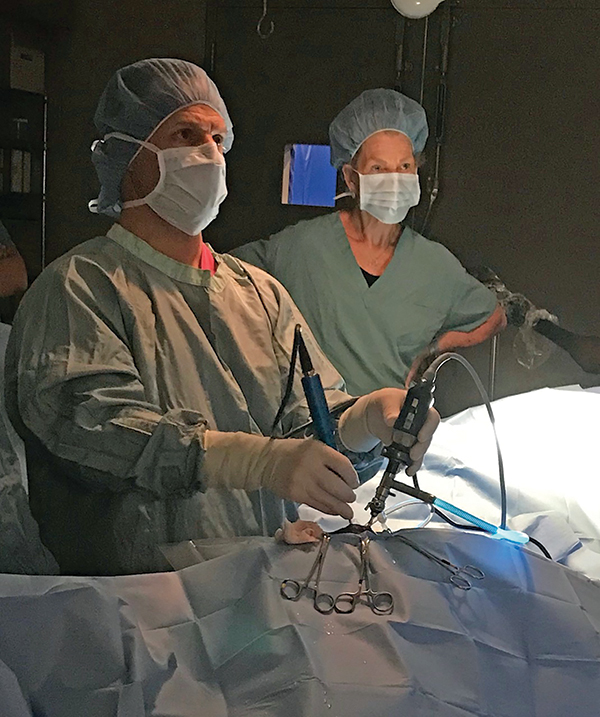
Kim Rose (right) was invited into the operating room during Julio’s surgery, which lasted for several hours. Photo courtesy of WCVM
Carmalt says that the disease has been found in all breeds of horses, but not in foals.
“The condyle of the mandible (the bony portion of the mandible that makes up half of the TMJ) undergoes major shape changes in the first six to twelve months of life. It is possible, but not confirmed, that some problems of this joint (such as cysts) are a type of developmental bone disease, like osteochondrosis, but we have no evidence for that yet.”
The research grant will fund two research goals. The first goal is to see if there are fundamental differences between cartilage types, as well as between joints with and without a meniscus.
Cartilage from four different sources will be used to assess the response to inflammation to the different cartilage types. They will be sourced from the stifle (hyaline cartilage/meniscus), fetlock (hyaline cartilage/no meniscus), TMJ (fibrocartilage/meniscus) and navicular bursa (fibrocartilage/no meniscus).
“Some joints have a meniscus,” he says. “This is a thick fibrous band of tissue that allows two bone ends of differing shape to move over each other without damaging the cartilage or creating pain. The most well-known of these is the meniscus of the knee (which is commonly damaged in soccer or football). The temporomandibular joint has a meniscus (also known as a disc) and the spine has discs between each of the vertebrae.
“We remove a small portion of normal cartilage from each of these four locations in horses that have been euthanized for reasons other than arthritis. We grow that cartilage in a flask. Then the cartilage cells (chondrocytes) are treated with lipo-polysaccharide (LPS). This causes irritation of the cells which respond by producing a cocktail of inflammatory and anti-inflammatory proteins. These are what we will be measuring.”
LPS is an endotoxin and it is a major component of the outer membrane of bacteria. Once the cartilage cells have been assessed according to their responses to inflammation, the team will determine the responses of the cartilage to different treatments, including IRAP II and Pro-Stride, corticosteroids, and hyaline cartilage. This will show if there are fundamental differences between cartilage types and between joints with and without meniscus.
IRAP II is used for osteoarthritis and for joint treatment in horses. IRAP stands for interleukin-1 receptor antagonist protein. The function of IRAP is to block, or tie up, proteins called cytokines that cause inflammation. Blood is withdrawn into a syringe containing specially treated chromium glass beads. The blood is cultured with the beads for 24 hours. These beads interact with the red blood cells which stimulates the production of anti-inflammatory proteins.
Pro-Stride works by blocking pro-inflammatory proteins. The process does not use beads. It is an autologous protein solution, meaning it is a solution derived from the horse’s own blood. It is a concentrate of plasma with white blood cells and enriched platelet growth factors. IRAP II and Pro-Stride are regenerative, biological treatments that work by stimulating the body’s own immune systems.
Related: Equine Sports Medicine
“IRAP II is based on serum (the liquid fraction of blood remaining after the red blood cells coagulate) and incubated with the glass beads,” says Carmalt. “Pro-Stride uses plasma (the liquid fraction of blood removed without letting the red blood cells coagulate) in a centrifugation and dehydration (concentrating) process. These result in a different cocktail of naturally occurring pro- and anti-inflammatory proteins as well as growth factors (proteins stimulating cellular growth and proliferation).”
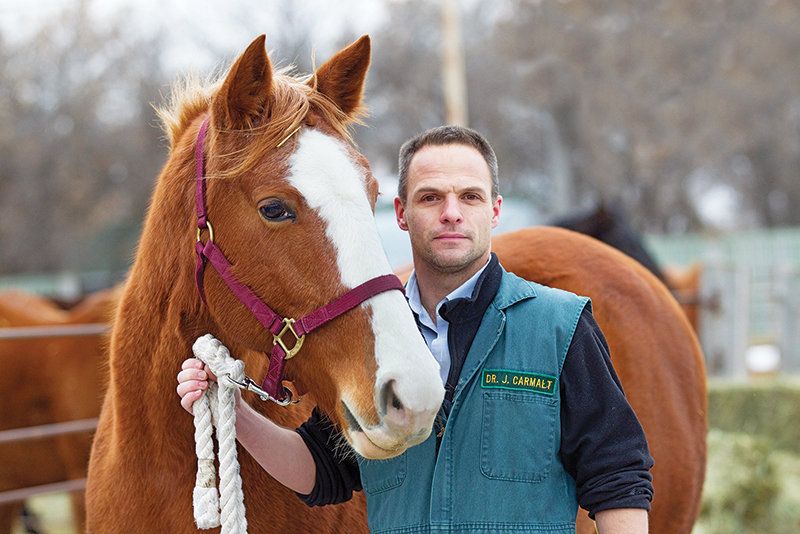
Dr. James Carmalt is a professor, Department of Large Animal Clinical Sciences, at the Western College of Veterinary Medicine, University of Saskatchewan. Photo courtesy of WCVM
The second goal is to assess the movement of appropriately trained horses on a treadmill using high quality kinematic cameras and markers. Carmalt says they will then induce short-term, self-limiting inflammation in one of the TMJs on each horse by using LPS as the short-acting, local inflammatory agent. LPS is used because it does not have long-term consequences on the joint or well-being of the horse and was specifically chosen so that the horses are subjected to as little discomfort as possible.
“We will look at movement at walk, trot, long-reining, and under saddle before, and after, inflammation,” he says. “We are hoping to show that the low-grade discomfort in the TMJ results in changes in movement that we can capture using the cameras and, more importantly, that the rider can ‘feel’ these changes and make corrective inputs. This research will be key to showing people that TMJ inflammation can result in movement aberrations and that this joint deserves more attention in cases of poor performance, or behaviour.”
Once Julio had arrived at WCVM in January, Carmalt and his team conducted a CT scan of both TMJs, a lameness exam with a lameness locator, radiographs of stifle joints and tarsometatarsal joints, as well as other procedures. By February it was decided to take a surgical approach, which was scheduled for June.
“I travelled to Saskatoon to be onsite and had the honour of being invited into the operating room to see the extent of the disease, which was far worse than the CT or ultrasound revealed,” says Rose. “The surgery was several hours in length as both joints were involved.”
Carmalt says they got into both joints, found and debrided the cysts in the mandibular condyles, and removed damaged disc material from the left discomandibular joint. They then put antibiotics, local anesthesia, and morphine into the joints after surgery to help with Julio’s discomfort. His recovery was uncomplicated. He got up with no problem and was soon eating.
Julio’s six-month stay in Saskatoon was possible because, fortuitously, his previous owner had moved to the city.
“Fortunately for me, the woman from whom I purchased Julio (at the time on Vancouver Island) had moved to Saskatoon,” says Rose. “He went back and forth [from WCVM] to her place and was out at pasture with her herd. I had to purchase him some new clothes for the -40 Celcius temps. When I loaded him on the trailer in January, I had no idea that he would be staying so long. So, I was able to wait while Dr. Carmalt and his team practiced their approach multiple times on ‘cadavers’ and were ready to perform the surgery on a bona fide clinical case. The coolest part is that the woman caring for Julio also owns his dam and sire, and so Dr. Carmalt had access to [them] and has examined Julio’s entire immediate family. I would not have been able to leave Julio if I didn’t know who he was with.”
Julio was discharged June 18 and returned home to Delta. On August 1, Rose says, under saddle work began.
Carmalt says they do not know how common TMD is. It seems to be an ambiguous disease that is often attributed to other issues. In one of his recently published papers, he reported that 36 percent of over 1,000 horses that had a computed tomography of the head for reasons not associated with TMJ disease – such as sinusitis or a tooth problem – also had abnormalities of their TMJs. He says it was interesting that this percentage closely matches that of humans who can also have TMD but without obvious clinical signs.
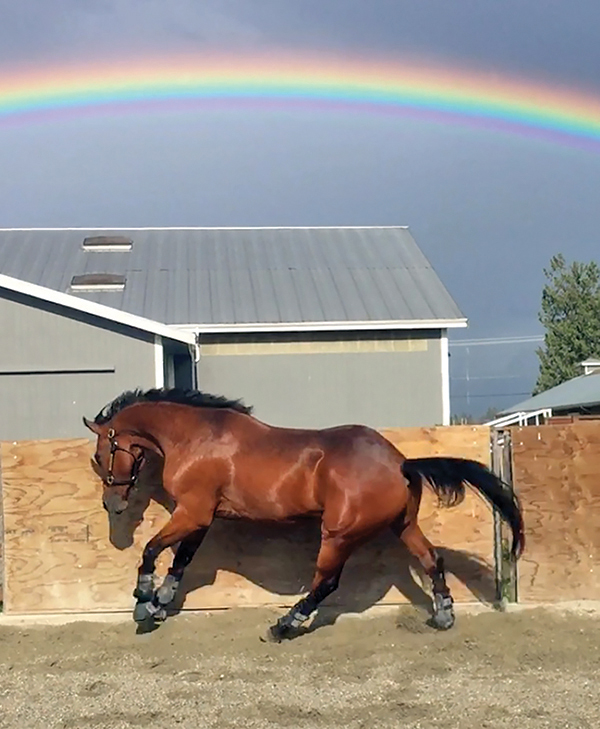
Photo: Kim Rose
“Thirty to forty years ago, diseases of the equine neck and back were overlooked and not considered important,” he says. “Today, those same diseases and injuries are high on the differential diagnosis list of equine clinicians. We believe that the equine TMJ has been overlooked because it is counter-intuitive to think that diseases of the equine head may cause lameness or poor behaviour. It is very difficult to find a problem if you don’t even look!”
It is also not known if this problem is genetic. At this stage of the research, Carmalt is trying to understand which horses have it and what the clinical significance is of the disease to the horse.
“We do know that arthritis subsequent to joint infection occurs in this joint, as well as other joints,” he says. “Additionally, we have diagnosed the problem in TMJs of horses that had trauma to the area (but were not diagnosed with an infected TMJ) in the past. Did one lead to the other? No idea, because no one thought about the TMJ at the time of the trauma. Perhaps the arthritis was already there. Alternatively, perhaps it came on after the trauma.”
He says that, once diagnosed or suspected, the TMJ is commonly injected with corticosteroids or hyaluronic acid. Corticosteroids are synthetic drugs that mimic cortisol, a naturally produced hormone. They are widely used for the treatment of conditions such as arthritis, skin ailments, and autoimmune diseases. Hyaluronic acid is a substance naturally produced by the body and found in the skin and joints. It retains water to keep tissues and the space between joints lubricated and prevent bones from grinding against each other, causing pain.
“Apparently there is some response, but my feeling is that this treatment is both incomplete and short-acting,” he says. “Whether this is because the fibrocartilage of this joint is fundamentally different from other joints is unknown. We assume that the earlier it is diagnosed the easier it is to treat, but we don’t have any evidence to support this supposition.”
In addition to behavioural issues, horses can provide more, if obscure, clues that the TMJ is amiss.
Related: An Inside Look at Joints
“One interesting thing that Julio used to do and what we thought was a cute thing was sticking his tongue out while being groomed or just hanging out in his paddock,” says Rose. “On the TMJ Facebook page, I posted about this and someone who suffers TMJ issues commented that sticking the tongue out is actually a prescribed ‘exercise’ to reduce pain. It turns out that Julio must have found some relief in sticking his tongue out and since his surgery has not been observed doing this at all.”
To gather information and find out what riders are experiencing and what veterinarians are seeing, Carmalt invites you to contact him through his Facebook page.
“When it comes to nebulous conditions such as neck, back, and TMJ problems, veterinarians are heavily dependent on information from the owner/rider/trainer when coming to a correct definitive diagnosis. So, I am very interested in owner/rider information. I have a Facebook page (Equine TMJ Disease). The goal of the page is to gather information and experience from owners, riders, trainers, and veterinarians to help build a more complete picture of this disease and its prevalence. Additionally, we want to try to build awareness of this condition in horses with the goal of helping horses that might otherwise go undiagnosed.”
One of the big challenges in diagnosing TMD is that its symptoms can be so ambiguous, and many times are simply mistaken as poor performance. Behaviour and resistance issues have owners looking at all kinds of curative options except looking at the jaw. It is too often the site of last resort or missed altogether, resulting in hundreds of horses being unnecessarily retired or sadly euthanized.
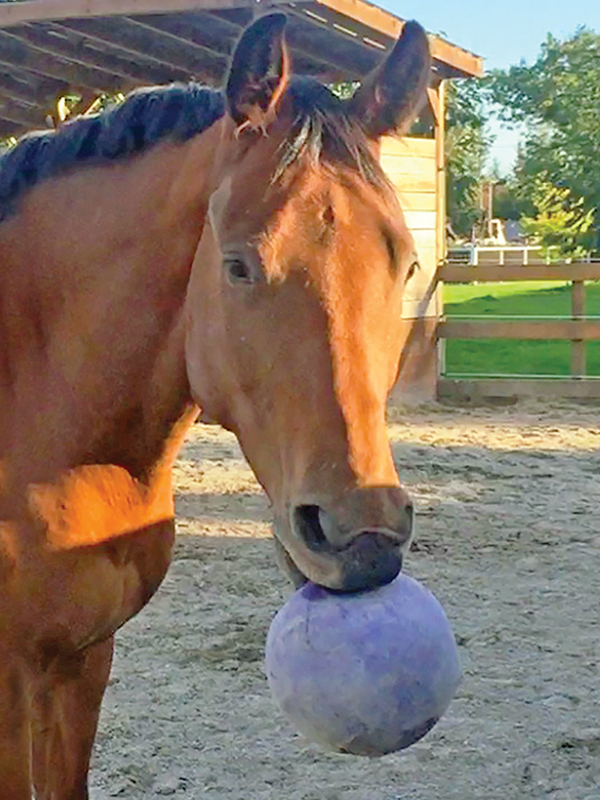
Photo: Kim Rose
Carmalt is grateful for the grant funding to take his research further and gain insights into TMJ conditions. He stated on his Facebook page that there are three major research groups looking at the disease. There is one in Germany focused on the microscopic level of the joint, one on the Pacific coast of the US looking at imaging, and their own group in Saskatoon.
“Our scope is relatively wide, encompassing advanced imaging, biomechanics, and the clinical aspects of the disease,” he says. “Additionally, we hope to investigate the role of the specialized cartilage in the disease process, and its treatment.”
Rose says that Julio is now happy, healthy, and most importantly, comfortable. His behaviour is predictable, and he appears to be content. Going forward, Rose recommends that riders pay close attention if their horse’s behaviour seems to change.
“Really listen to your horse, understand equine anatomy in general and specifically the importance, function, [and] sensitivity of the equine TMJ. I also feel that increasing knowledge and awareness amongst riders, trainers, [and] competitors will improve human empathy in training techniques and equipment used.”
The financial assistance generously given by the DuMont family will go a long way to uncovering the mysteries of TMJ and the disease that plagues the joints.
Mark and Pat DuMont live on a farm near Langley, BC and they have a key interest in equine musculoskeletal health. They created the Mark and Pat DuMont Equine Orthopedics Research Fund in 2013 and, in the past six years, the fund has invested $600,000 in WCVM-based equine research studies. Funds have helped to understand key health issues such as septic joint arthritis, caudal heel pain, and wound healing. In addition to the funds for TMJ research, they also provided $70,000 in funding to Dr. Claire Card who is in the same department as Carmalt. She is doing research on iodine and thyroid hormones in musculoskeletal health in horses.
“Given the severe changes observed in Julio’s TMJs, there is, of course, concern for his long-term prognosis,” says Rose. “At some point it is expected that he may experience pain [and] symptoms and will require further management of his TMJ disease.
“Julio and Dr. Carmalt and his team have provided an amazing learning experience for me. I have been riding, training, and coaching for a very long time and always do my best to really ‘listen’ to the horses I have the pleasure of working with. “Julio’s past behaviour, although sporadic, caused me to explore and research, resulting in my online discovery of Dr. Smythe’s thesis on equine TMJ disease and him subsequently putting me in touch with Dr. Carmalt. I feel truly blessed to have direct contact with Dr. Carmalt and the WCVM team involved in this journey.”
Main article photo: Shutterstock/Sharon Morris
This article was originally published in the Autumn 2019 issue of Canadian Horse Journal.




